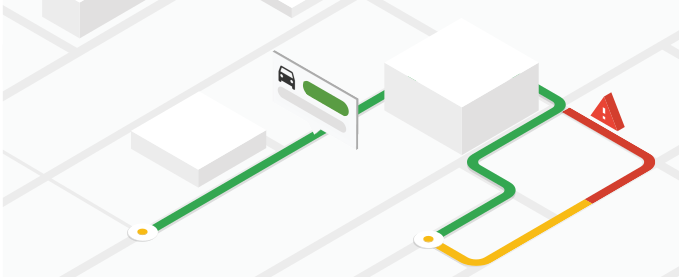
Dlaczego warto korzystać z interfejsu Directions API
Za pomocą interfejsu Directions API możesz uzyskiwać wskazówki dojazdu różnymi środkami transportu, np. transportem publicznym, samochodem, pieszo lub rowerem.
Co można robić za pomocą interfejsu Directions API?
Interfejs Directions API umożliwia obliczanie tras między lokalizacjami, w tym podawanie tych szczegółów:
- Wskazówki dojazdu różnymi środkami transportu, w tym transportem publicznym, samochodem, pieszo lub rowerem.
- Wieloczęściowe wskazówki wykorzystujące serię punktów kontrolnych.
- Możesz określić punkty początkowe, docelowe i trasy na wiele sposobów, w tym jako ciągi tekstowe (na przykład „Chicago, IL” lub „Darwin, NT, Australia”), identyfikatory miejsc lub współrzędne szerokości i długości geograficznej.
Jak działa interfejs Directions API
Interfejs API Directions zwraca najbardziej efektywne trasy podczas obliczania wskazówek dojazdu. Podczas wyznaczania najbardziej efektywnej trasy usługa uwzględnia te elementy podróży:
- Czas podróży (podstawowy)
- Odległość
- Liczba zwojów
Poniższy przykładowy request zwraca wskazówki dojazdu z Toronto w Ontario do Montrealu w Quebecu w formacie JSON:
https://maps.googleapis.com/maps/api/directions/json ?destination=Montreal &origin=Toronto &key=YOUR_API_KEY
Zasoby
Poniższa tabela podsumowuje zasoby dostępne za pośrednictwem interfejsu API Directions wraz z danymi zwracanymi przez interfejs.
| Zasoby danych | Zwrócone dane | Format zwrotu |
|---|---|---|
| Trasa
Podaj miejsca początkowe i docelowe w postaci identyfikatorów miejsc, adresów lub współrzędnych geograficznych. Więcej informacji znajdziesz w sekcji Parametry wymagane. |
Szczegółowe wskazówki podzielone na trasy, etapy i kroki. Szczegółowe informacje znajdziesz w sekcji Odpowiedzi dotyczące wskazówek dojazdu. |
|
Jak korzystać z interfejsu Directions API
| 1 | Skonfiguruj konto. | Zacznij od skonfigurowania projektu Google Cloud i postępuj zgodnie z instrukcjami konfiguracji. |
| 2 | Wypróbuj wersję demonstracyjną | Gdy uzyskasz klucz interfejsu API i projekt w chmurze, możesz bezpłatnie wypróbować wersję demonstracyjną wskazówek. Zobacz demonstrację interfejsu Directions API. |
| 3 | Tworzenie żądania | Zobacz przykładowe żądania i dowiedz się więcej o dostępnych opcjach, które możesz podać, takich jak tryby podróży, punkty pośrednie i ograniczenia trasy. Zobacz przykłady dotyczące wskazówek. |
| 4 | Zrozum podstawy odpowiedzi | Zapoznaj się z odpowiedziami dotyczącymi danych, aby przygotować się do wykorzystania danych dotyczących wskazówek dojazdu w swojej aplikacji. Szczegóły znajdziesz w sekcji Odpowiedzi dotyczące wskazówek dojazdu. |
| 5 | Dodaj dane dotyczące kierunku do swojej aplikacji! | Na podstawie tych danych możesz obliczyć odległość i czas podróży. |
Dostępne biblioteki klienta
Wywołaj ten interfejs API w wybranym języku za pomocą jednej z tych bibliotek klienta:
- Klient Java usług Map Google
- Python Client for Google Maps Services
- Go Client for Google Maps Services
- Node.js Client for Google Maps Services
Klient Java, klient Python, klient Go i klient Node.js dla usług Map Google to biblioteki klientów obsługiwane przez społeczność, udostępniane na licencji Apache 2.0. Możesz je pobrać z GitHuba, gdzie znajdziesz też instrukcje instalacji i przykładowy kod.
Co dalej?
- Rozpocznij korzystanie z interfejsu Directions API: otwórz stronę Pierwsze kroki.
- Zacznij wysyłać zapytania o trasę: otwórz stronę Wyznaczanie trasy.
- Postępuj zgodnie z najlepszymi praktykami: Przejdź do sekcji Najlepsze praktyki dotyczące usług sieciowych.

